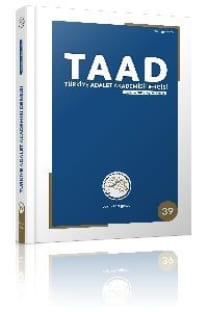ABD BAŞKANLIK SİSTEMİNDE FREN VE DENGE MEKANİZMASI ÜZERİNE BİR İNCELEME
Başkanlık, Kongre, Kuvvetler Ayrılığı, Fren ve Denge Araçları
An Examination on Checks and Balances Mechanism in USA Presidential System
Presidency, Congress, Seperation of Power, Checks and Balances Tools,
___
- AKMAN-ASLAN, Canan, Başkanlık Sistemlerinin Latin Amerika Deneyimi: Çok-Parti Sistemlerindeki Çeşitlilikler, Sorunlar ve Fırsatlar, (Ed.) KAMALAK, İh- san (İç) Başkanlık Sistemi ve Türkiye, 2007.
- ATAR, Yavuz, Demokrasilerde Anayasal Değişmenin Dinamikleri ve Anayasa Ya- pımı, Konya, 2000.
- BEUTLER, Brain, Revealed: Bush’s Presidential Signing Statements Have Been Used to NullifyLaws,www.alternet.org/story/54543/revealed%3A_bush’s_ presidential_signing_ statements _have_been_ used_ to_nullify_laws
- BRADBURY, Steven G. Officers of the United States Within the Meaning of the Appointments Clause, Opinion of the Office of Legal Counsel, Vol.31, 2007.
- BRADLEY, Curtis A. POSNER, Eric A., Presidential Signing Statements and Exe- cutive Power, Constitutional Commentary. Vol.23, 2006.
- DELLINGER, Walter, Whether Uruguay Round Agreements Requıred Ratıfıca- tıon As A Treaty, www.justice.gov/olc/gatt.htm DELLINGER, Walter, The Legal Significance of Presidential Signing Statements, www.justice.gov/olc/signing.htm DURGUN, Şenol, Parlamenter Yapılar ve Parlamenterlerin Temsil Gücü, Anka- ra, 2005.
- GARVEY, Todd, Presidential Signing Statements: Constitutional and Institutio- nal Implications, Congressional Research Service, (Summary) 2012.
- GÖZLER, Kemal, Anayasa Hukukunun Genel Esasları Ders Kitabı, Bursa, 2011.
- HEKİMOĞLU, Mehmet, Merdan, Anayasa Hukukunda Karşılaştırmalı Demok- ratik Hükümet Sistemleri ve Türkiye, Ankara 2009.
- KATHY, Gill, Bills Vetoed by President Bush, www.uspolitics.about.com/od/ electionissues/tp/Bush-Vetos. Htm. KINKOPF, Neil, SHANE, Peter M. Signed Under Protest: A Database of Presi- dential Signing Statements, 2001-2009, Public Law and Legal Theory Working
- Paper Series No. 141, 2011. www.papers.ssrn.com/sol3/papers. cfm?abstra- ct_ id=1748474
- KUZU, Burhan, Türkiye için Başkanlık Sistemi, www.tesam.org.tr/download/ burhankuzu.pdf. LIENERT, Ian, Role of the Legislature in Budget Processes, International Mone- tary Fund, 2010.
- McMURTRY, Virginia A. The Impoundment Control Act of 1974: Restraining or Reviving Presidential Power? Public Budgeting & Finance, Vol. 17, 1997.
- MODIRZADEH, Naz K. Counterterrorism and Humanitarian Engagement Proje- ct, Congressional Inquiries, Mart, 2013.
- MUNSON, Holly, What’s a Presidential Signing Statement? www.blog.consti- tutioncenter.org/2012/01/ whats-a-presidential-signing-statement/
- ÖRGÜN, Faruk, Dar Gelen Gömlek Başkanlık Sistemi, İstanbul, 1999.
- ÖZBUDUN, Ergun: İngiltere ve Amerikada Meclis Tahkikatı, AÜHF Dergisi, C.17, S.1-4, 1960.
- ÖZER, Attila, Başkanlık Hükümeti Sistemi ve Bu Sistemin Türkiye Açısından Uy- gulanabilirliği. 2.Baskı. Ankara 1998.
- PALMER, Erin Louise, Reinterpreting Torture: Presidential Signing Statements and the Circumvention of U.S. and International Law, American University Washington Collage of Law, Human Rights Brief 14. No. 1, 2006.
- PFIFFNER, James, Organizing The Twenty First Century White House, (ed.) THURBER, James, (iç) Rivals for Power: Presidential-Congressional Relations, Maryland, 2013.
- POSNER, Paul, PARK, Chung-Keun, Role of The Legislature In The Budget Pro- cess: Recent Trends and Innovations, OECD Journal on Budgeting. Vol.7, No. , 2007.
- SCHNEIDER, Judy, The Committee System in the U.S. Congress, www.usinfo. org/enus/government/branches/docs/committee_system.pdf. SHIMBERG, Steven, Checks and Balance: Limitations on the Power of Congres- sional Oversight, Law And Contemporary Problems, Vol.54, No.4, 1991.
- THURBER, James A. The Dynamics and Dysfunction of the Congressional Bu- dget Process: From Inception to Deadlock, s.1. www.american.edu/spa/ccps/ upload/Congressional-Budget-Process-article.pdf TUNÇ, Hasan, YAVUZ, Bülent, Avantaj ve Dezavantajlarıyla Başkanlık Sistemi. T.B.B. Dergisi Sayı:81. 2009.
- TURAN, İlter, Başkanlık Sistemi Sevdası: Zayıf Temelli Bir Özlem, T.B.B. Yayını (İç.) Başkanlık Sistemi, Ankara 2005.
- TURHAN, Mehmet, Hükümet Sistemleri ve 1982 Anayasası, Diyarbakır, 1989.
- ULUŞAHİN, Nur, Anayasal Bir Tercih Olarak Başkanlık Sistemi, Ankara 1999.
- ULUŞAHİN, Nur, Saf Hükümet Sistemleri Karşısında İki Başlı Yürütme Yapılan- ması, Ankara 2007.
- WATERMAN, Richard W. Waterman, Presidential Signing Statements: The Constitutional Versus the New Government Models, Advanced Placement Program, Government and Politics: United States Balance of Power Between Congress and the President, 2008.
- YAZICI, Serap, Başkanlık Sistemleri: Türkiye İçin Bir Değerlendirme. T.B.B. Yayı- nı (İç) Başkanlık Sistemi, Ankara, 2005.
- YAZICI, Serap, Başkanlık ve Yarı Başkanlık Sistemleri Türkiye İçin bir Değerlen- dirme, İstanbul, 2001. İNTERNET KAYNAKLARI www.abrahamlincolnonline.org/lincoln/ speeches/emancipate.htm www.senate.gov/reference/Legislation/Vetoes/BushGW.htm www.supreme.justia.com/cases/federal/us/354/178/case.html www.senate.gov/pagelayout/committees/d_three_sections_ with_teasers/ committees_ home.htm www.house.gov/committees/ www.legal-dictionary. thefreedictionary.com/Congressional+immunity www.historyplace.com/ unitedstates/impeachments/nixon.htm (clinton. htm) (johnson.htm)
- Committee History, www.waysandmeans.house.gov/about/history.htm Structure of Congress, www.etech.northern.edu/ blanchak/pols100/ pols- lectures/ congress.structure.htm ABD Anayasası (Açıklamalı) www.photos.state.gov/libraries/turkey/ 231771/ PDFs/abd-anayasasi.pdf
- Composition of Congress, by Political Party, 1855–2015. www.infoplease. com/ipa/A0774721.html
- Presidential Signing Statements Research Guide, www.law. georgetown.edu/ library/research/guides/presidentialsigningstatements.cfm United States Government Accountability Office (GAO), Presidential Signing Statements Accompanying the Fiscal Year 2006 Appropriatons Acts (Report) 06.2007, www.gao.gov/decisions /appro/308603.pdf
- Vetoes by President George W. Bush, www.senate.gov/reference/Legislation/ Vetoes/BushGW.htm Executive Office of the President, www.whitehouse.gov/administration/eop The Impeachment Process: 1998, www.nytimes.com/learning/general/speci- als/impeachment/
- Overview, www.cbo.gov/about/overview Common Pool, www.investopedia.com/terms/c/common-pool.asp Legislative Branch, www.whitehouse.gov/our-government/legislative-branch
- ISSN: 1309-6826
- Yayın Aralığı: 4
- Başlangıç: 2010
- Yayıncı: Türkiye Adalet Akademisi
İYUK MADDE 28/4 DEĞİŞİKLİĞİ: YARGI KARARLARININ İDARE TARAFINDAN UYGULANMAMASI VE ÇÖZÜM ÖNERİLERİ
AZERBAYCAN CUMHURİYETİ YARGI SİSTEMİ
AVRUPA İNSAN HAKLARI MAHKEMESİ KARARLARINDA İFADE HÜRRİYETİNİN SINIRLANDIRILMASI
AVRUPA İNSAN HAKLARI MAHKEMESİ VE ANAYASA MAHKEMESİ KARARLARI IŞIĞINDA MAHKEMEYE ERİŞİM HAKKI
HAKSIZ FİİLDE CEZA ZAMANAŞIMI SÜRESİ
AVRUPA BİRLİĞİ’NE ÜYE ÜLKELERDE ESNEK PERSONEL REJİMİ VE TÜRKİYE UYGULAMALARININ KISMİ BİR ANALİZİ
Mustafa AVCI, Seçkin YAVUZDOĞAN
ALMAN İÇTİMA ÖĞRETİSİNDE DOĞAL HAREKET TEKLİĞİ
6545 ve 6552 SAYILI KANUNLAR ÇERÇEVESİNDE İDARİ YARGILAMA USÛLÜ DEĞİŞİKLİKLERİ
